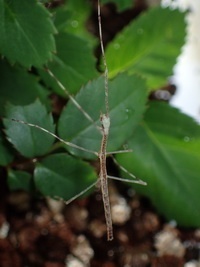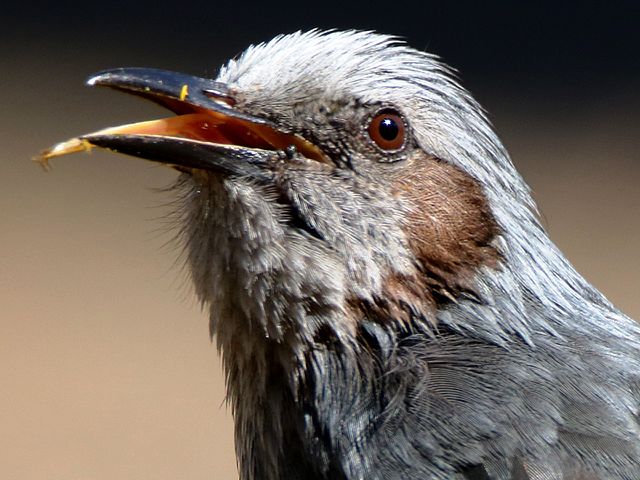Bird disperses eggs of stick insects it swallowed
Some stick insects are even more like plants than you might think at first glance. Just like plant seeds, the eggs can be dispersed by a bird, Kenji Suetsugu and colleagues show.
Stick insects are perfectly camouflaged: they do not stand out among the plants. Yet insect-eating birds are able to find them and will eat them. And that is the end of the story for such tiny animal.
Well, it may not be, Kenji Suetsugu and colleagues report. If an unfortunate female stick insect is carrying mature eggs, a few of these appear undamaged in the bird’s droppings, and some may even hatch.
Younsters
The researchers, working in Japan, point out that the eggs of stick insects resemble plant seeds: they have the same size and colour and feel the same thanks to a hard shell. Hence their suggestion that the eggs might survive passage through a bird’s digestive tract like plant seeds do. Many plant species produce fruits that are eaten by birds or other animals; the seeds remain intact, are excreted and germinate. Is something similar possible for the eggs of stick insects?
 To find out, they mixed mature eggs of three stick insect species with an artificial diet and fed this to a brown-ear bulbul, one of the main predators of the insects. Afterwards, they examined the bird’s droppings under a stereomicroscope and discovered a small number of intact eggs, and from some of these eggs a young stick insect hatched later on.
To find out, they mixed mature eggs of three stick insect species with an artificial diet and fed this to a brown-ear bulbul, one of the main predators of the insects. Afterwards, they examined the bird’s droppings under a stereomicroscope and discovered a small number of intact eggs, and from some of these eggs a young stick insect hatched later on.
Such scenario is also possible when a bird swallowed a gravid female, the authors think. The youngsters that hatch after passage through a bird’s guts would have to find an appropriate food plant to live on, but that is always the case. Normally, a female just drops her eggs to the ground and does not provide any care.
Parthenogenetic
 So, sick insects not only look like plants, but they also exhibit a surprising plant-like trait: dispersal of offspring by birds, which is unique in insects.
So, sick insects not only look like plants, but they also exhibit a surprising plant-like trait: dispersal of offspring by birds, which is unique in insects.
Dispersal by an avian predator is only possible for species that reproduce parthenogenetically, for in that case females carry eggs that can develop without fertilization. A number of stick insect species exhibit parthenogenesis, including the species that were studied here.
Flyways
Dispersal of insect eggs via a bird’s digestive tract is not entirely comparable to dispersal of plant seeds. Plants produce fruits that have to be eaten to disperse their seeds. In contrast, a female stick insect has no intention to be captured by a bird to have her eggs transported – by being camouflaged, she tries to prevent just that. But if she is unlucky enough to become a bird’s meal, it is a collateral benefit if some eggs survive and young hatch, if only a few.
The hard eggs probably have not evolved to facilitate avian dispersal, the authors suggest, but to decrease the risk of attack by parasitoid wasps, which lay their eggs in other insects’ eggs.
Stick insects are immobile. Thanks to the birds they may reach new places to live. An interesting question is whether distribution patterns in the insects, to be unravelled by DNA research, overlap with birds’ flyways; that would strengthen the idea that the eggs are sometimes dispersed like plant seeds.
Willy van Strien
Photos
Large: Brown-eared bulbul (tongue visible). Alpsdake (Wikimedia Commons, Creative Commons BY-SA 4.0)
Small: stick insect (Ramulus irregulariterdentatus) eggs that passed through a bird’s digestive tract and a young stick insect that hatched from such egg. ©Kenji Suetsugu
Source:
Suetsugu, K., S. Funaki, A. Takahashi, K. Ito & T. Yokoyama, 2018. Potential role of bird predation in the dispersal of otherwise flightless stick insects. Ecology, online May 29. Doi: 10.002/ecy.2230
